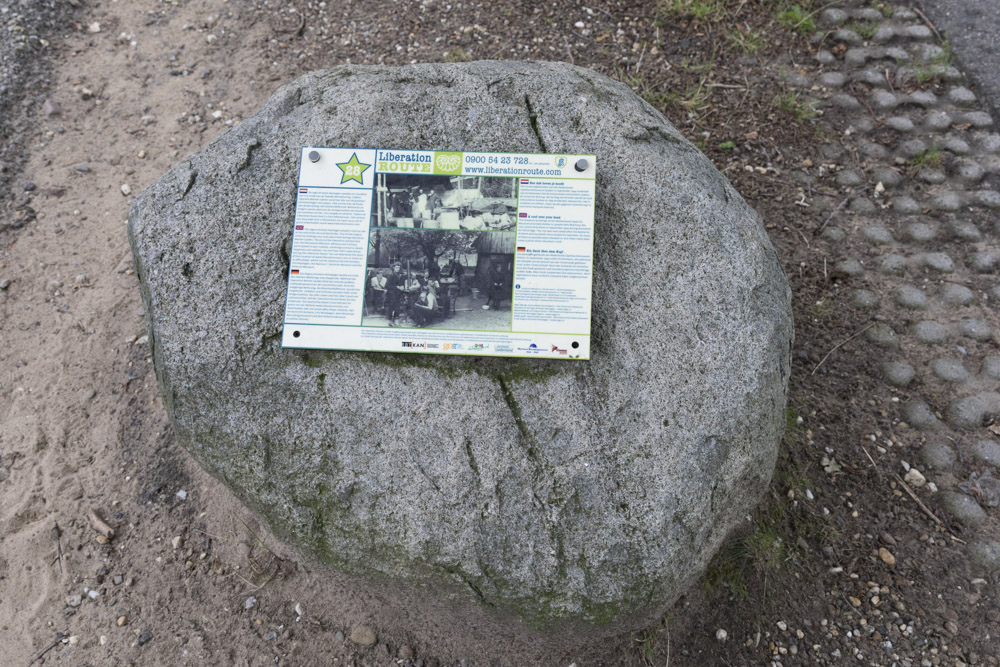Liberation Route Marker 028
Liberation Route Europe is a certified Cultural Route of the Council of Europe. With hundreds of sites and stories in nine European countries, the route links the main regions along the advance of the Allied Forces in 1943-1945.
The entire route consists of themed routes that can be travelled by by hiking, walking, cycling and car. These routes pass numerous historical and interesting sites and tell stories from a multitude of perspectives that were important in the final phase of World War II.
Many routes feature listening spots, offering the opportunity to listen to a historical story at a location. In addition, many ‘Vectors of Memory’ have been placed, indicating that the passer-by is on one of the Liberation Routes.
The routes can be found on the Liberation Route Europe website or in the app through which many stories can also be listened to.
A roof over your head
The museum buildings of the Netherlands Open Air Museum provided shelter to people who fled from the city centre of Arnhem in September 1944 during the battle for the bridge. The city was evacuated after the Battle for Arnhem and hundreds more people arrived then. As many of them as possible were allowed in, but there really does come a point when the place is full.
In September 1944, 10,000 British soldiers landed near Arnhem in an attempt to secure the bridge over the River Rhine. The operation failed and Arnhem became a front-line city. On 24th September, the Germans gave the order to evacuate the town centre. On 5th November it was the Alteveer district's residents' turn to leave their homes. The nearby open air museum seemed like a suitable place to take shelter. There was enough room for 200 evacuees at the Open Air Museum, but 600 turned up. They took shelter in the houses, the farms and the exhibition buildings.
People found food in the deserted town and both staff and the evacuees used the central kitchen to cook in. The traditional Marken fisherman's house was turned into a shop. There was a bakers in the brewery and people would fetch water from the well. During the day, the women would do household chores whilst the men found tasks to occupy themselves with, often similar to their own professions. They would also fetch the water, chop wood or dig the potatoes. In the meantime, museum staff stored away as many of the valuable artefacts as they could. On 3rd November, after a raid by the Germans, the evacuees were forced to leave the museum's grounds. Eighty people were eventually allowed to stay and soon, new evacuees started to arrive, taking this number up to 150. On 19th December, the Germans ordered everybody to leave the Open Air Museum.
Audiospot - A roof over your head
Do you have more information about this location? Inform us!
Source
- Text: TracesOfWar & Liberationroute.com
- Photos: Arjan Vrieze
Nearby
Museum
- Open Air Museum Arnhem - Arnhem
- Historical Museum Grenadiers and Hunters - Arnhem
- Historical Collection Regiment Van Heutsz - Arnhem
Point of interest
- Replica Wire of death First World War Open Air Museum - Arnhem
- Site Former Ehrenfriedhof Zijpendaal - Arnhem
- Saxony-Weimarbarracks Arnhem - Arnhem
Monument
- Evacuation 1944 Memorial Open Air Museum Arnhem - Arnhem
- Memorial Killed Employees Van Gend & Loos - Arnhem
- Memorial "De Pleuranten" General Cemetery Moscowa Arnhem - Arnhem
Cemetery
- Dutch War Graves General Cemetery Moscowa Arnhem - Arnhem
- Commonwealth War Graves General Cemetery Moscowa Arnhem - Arnhem
- Commonwealth War Grave Jewish Cemetery Moscowa Arnhem - Arnhem
Remembrance Stone
- Stumbling Stone Van Heemstralaan 63 - Arnhem
- Stumbling Stones Bakenbergseweg 129 - Arnhem
- Stumbling Stones Rembrandtlaan 31 - Arnhem
Fortification
- Two Kockbunkers Museum Arnhem - Arnhem
- Kochbunker Arnhem - Arnhem
- Diogenes Bunker Schaarsbergen - Schaarsbergen







